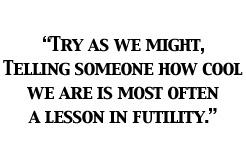3 Ways to Communicate Your Corporate Culture
In a meeting today with a new client, a conversation arose regarding their strong and positive feelings for their corporate culture, how important they thought it was, and that the challenge now was how to communicate that culture to their audience (which I'll just suppose for the sake of this post is two-fold: prospective clients and prospective job candidates).
I was glad to hear about a client's interest in culture. In my mind culture is fundamental to doing good business, and I agree that finding a way to communicate the essence of a firm's culture beyond the circle of existing clients is key to influencing prospects and talent through marketing efforts. But try as we might, telling someone how cool we are is most often a lesson in futility.
Rather than treat this as a problem of communication, then, maybe it's more helpful to think about it as a problem of transparency. We don't need to tell people about us as much as we need them to see us for who we really are. This shift in perspective changes the nature of our efforts, as we're focused less on how to talk to those we want to influence, than we are on how to make sure that we can be seen "doing business," just as we're already doing every day.
Think "Dynamic," not "Static"
"Doing business" implies action, change, adaptation and motion. Therefore, if we want to make our business transparent it will take more than a static brochure. Blogging is useful in this regard, and is one of the best tools to ever come along to provide a means of frequently publishing new content; content that reflects an ever-evolving culture through the views of its people.
It is not a single post that creates transparency as much as a steady stream of posts from different minds and personalities within the firm, all of which paint a dynamic representation of culture. To me the most beautiful characteristic of blogging is that done well it has such a powerful, authentic voice. Blogging is the voice of a human, which will always be more interesting and persuasive than a brochure.
Think "Engagement," not "Reach"
Some marketing efforts are deemed successful when they reach their audience; others when they successfully persuade on a call to action. But transparency calls for engagement. Until an audience can witness how a firm behaves in or responds to a given scenario, there's little from which to understand something so complex as culture.
Blogging, once again, often opens an avenue for conversation. But transparency is truly the domain of social media. Through one-to-one engagements taking place in a public context, transparency is born naturally, authentically, and believably. If I can see how you treat others on Facebook, I can't help but feel like that's how you'll treat me when I'm sitting across from you at the conference table.
Think "Now," not "Later"
Traditionally we have created marketing collateral that has a lifespan of weeks, months or even years; be it brochures or websites. Today our most impactful collateral has hardly a day to live. Our best opportunities to persuade are only moments in time, occurring at unpredictable intervals when a customer expresses frustration on Twitter or when situations beyond our control provide immediate opportunities to get unexpected press coverage. To leverage these moments we must be prepared to act immediately, and immediacy can only be achieved through the empowerment of individuals throughout the organization to act on behalf of the organization. If that doesn't create transparency—and reveal culture—then I don't know what will.
Related Articles
MONTHLY MARKETING INSIGHTS.
Get thought-provoking and actionable insights to improve how your firm makes a connection with your customers.






LEAVE A COMMENT